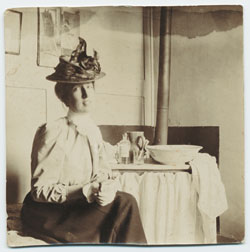Mary Foote facts for kids
Mary Foote (1872–1968) was an American painter. She also helped organize the notes from the seminars of a famous psychologist, Carl Jung.
As an artist, she lived and worked in places like New York City (specifically Washington Square Park), Paris, and Beijing. From 1928 until the 1950s, she lived in Zurich, Switzerland. There, she worked on publishing notes from Carl Jung's seminars. She returned to the United States in the 1950s and spent her later years in Connecticut, where she passed away.
Contents
Early Life
Mary Foote was born in Guilford, Connecticut. Her parents were Charles Spencer Foote and Hannah Hubbard Foote. She had a younger sister, Margaret Foote Hawley, who also became an artist.
Mary became an orphan at age 13. She was then cared for by an aunt in Hartford, Connecticut. For a time, Mary lived in the home of the famous writer Mark Twain (Samuel L. Clemens) and was friends with his daughter, Susy Clemens.
Mary Foote was a member of the Daughters of the American Revolution. This group is for descendants of people who helped during the American Revolution. Mary was a great-great-granddaughter of General Andrew Ward, a hero of the Revolution.
Career as an Artist
Mary Foote began studying art at the Yale School of Art in 1890. She was a very talented student. In 1894, she won the Alice Kimball English Prize, which helped her travel for art.
In 1897, she won an even bigger award, the William Wirt Winchester Prize. This prize allowed her to study art in Europe for two years. It was considered the largest art prize of its kind in the United States back then.
Foote traveled to Paris, France, where she studied with famous artists like John Singer Sargent and Frederick MacMonnies. She often painted the beautiful gardens at Giverny, France. She also painted a portrait of her teacher, Frederick MacMonnies.
Mary Foote had many famous friends, including art supporters, dancers like Isadora Duncan, and writers like Henry James and Gertrude Stein.
In 1901, she came back to New York City. She opened her own art studio in Washington Square Park. She earned a good living by painting portraits for many important people of her time. Mary painted all sorts of subjects, including people, flowers, and landscapes.
Her artwork was shown in important places like the Pennsylvania Academy of the Fine Arts. Her paintings were displayed alongside other well-known artists. At the famous Armory Show in 1913, she showed her painting called Old Lady.
Mary Foote also lived and worked in Peking (now Beijing), China, for a short time in 1926 and 1927.
Working with Carl Jung
After facing some personal difficulties, Mary Foote closed her art studio in 1927. A friend suggested she visit Carl Jung, a famous psychologist in Zurich, Switzerland.
Starting in 1928, Mary Foote began working for Jung. She would take notes during his seminars and help edit his English writings. She then helped create bound copies of these notes for the people who attended the seminars. For example, her notes became the basis for a book called The Visions Seminars, published later in 1976.
Her work was supported by people who subscribed to the notes. Mary Foote also helped pay for the work herself, and later, Paul and Mary Mellon and Alice Lewisohn Crowley also contributed.
Later Years and Death
In the 1950s, Mary Foote returned to Connecticut. She passed away on January 28, 1968, among her friends. She is buried in the Foote-Ward Cemetery in Guilford, Connecticut. Her personal papers are kept at the Yale University Library.
Works
- August Florian Jaccaci, oil, Century Association 7, New York
- Augustus Saint-Gaudens, oil, National Academy of Design
- Carrie Chapman Catt (1859-1947), oil on canvas, 1927, Smithsonian Institution National Portrait Gallery
- Floral Still Life, oil, Lagakos-Turak Gallery, Philadelphia, Pennsylvania in 1987
- Frederick MacMonnies, made by 1905
- Girl and Reflection, oil on canvas
- John Crosby Brown, 1914, Chamber of Commerce of the State of New York
- Jose Santo and Mother, oil on canvas, Smithsonian Institution National Museum of the American Indian
- Lady in Lavender, oil, about 1898-1901
- Mabel Dodge Luhan, oil on canvas, Yale University
- Naiad, Paris, oil on canvas
- Oriental Girl with Doll, oil on canvas, about 1898-1901
- Paul Draper
- Portrait of Mrs. Wilfred Worcester, oil on canvas, about 1898-1901
- Rio Grande Woman, oil on canvas, about 1920, National Museum of the American Indian. Made in New Mexico.
- Ruth Dana Draper (1850-1914), oil on canvas, about 1910. She was the wife of William H. Draper.
- Ruth Draper (1884-1956), oil on canvas, Smithsonian Institution National Portrait Gallery. She was an actress.
- Taos Man, oil on canvas, about 1920, National Museum of the American Indian. Made in New Mexico.
- Thomas Hastings, oil, National Academy of Design
- William H. Dunwoody, oil on canvas, 1913, Minnesota Historical Society, St. Paul, Minnesota
Images for kids
-
Mary Foote, Old Lady, shown at the Armory Show in 1913
-
Mary Foote, Portrait of Hiram Bingham III, 1921
See also
 In Spanish: Mary Foote para niños
In Spanish: Mary Foote para niños







